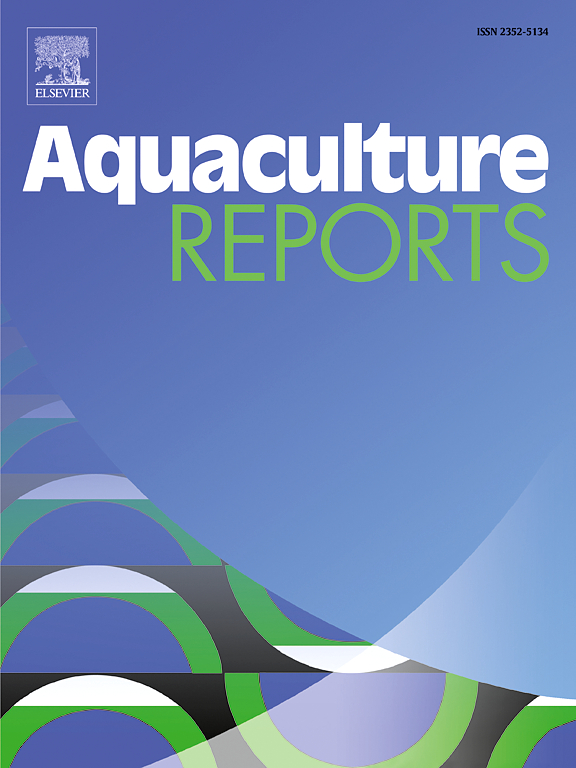Study on the aquaculture capacity of whiteleg shrimp (Litopenaeus vannamei)-razor clam (Sinonovacula constricta) tandem mariculture pond
IF 3.2
2区 农林科学
Q1 FISHERIES
引用次数: 0
Abstract
Tandem aquaculture mode is an innovative and burgeoning approach in aquaculture, designed to enhance aquatic biological production while achieving zero discharge of aquaculture effluent. By optimizing aquaculture density, this mode can fully exploit its potential advantages. In this study, we constructed tandem culture ponds (a shrimp pond with an area of 8000 m2 and a razor clam pond with an area of 4000 m2) in the coastal area, and the polyculture pond (with an area of 2600 m2) was used as the control. The experiment lasted a total of 317 days (including 32 days of shrimp culture), and initial stocking densities (razor clams: 487 ind/m2, shrimp: 40 ind/m2) and sizes (razor clams: 0.19 ± 0.05 g, shrimp: 0.38 ± 0.08 g) remained consistent in both modes. Through monthly sampling, we estimated the carrying capacity of Sinonovacula constricta by Parsons T R & Takahashi M Trophic Efficiency Method and Tait coastal waters energy flow analysis model. The carrying capacity of Litopenaeus vannamei was estimated by using models based on non-ionic ammonia emission standard and nitrogen emission standard. Results show that the carrying capacity of S. constricta estimated by the two models was 364 ind/m2 and 427 ind/m2 in the tandem culture pond, and the carrying capacity of L. vannamei estimated based on the two emission standards was 73 ind/m2 and 64 ind/m2. At the same time, it was estimated that the carrying capacity of S. constricta in the traditional polyculture pond was 88 ind/m2 and 103 ind/m2 respectively, and that of L. vannamei was 42 ind/m2 and 31 ind/m2 respectively. Converting the model results to yields, we found that both razor clam and shrimp yields were significantly higher (p < 0.05) in the tandem culture mode (clams: 6.81 ± 0.38 kg/m2, shrimp: 1.24 ± 0.06 kg/m2) than in the polyculture culture mode (clams: 0.77 ± 0.06 kg/m2, shrimp: 0.47 ± 0.03 kg/m2). Accounting for yield, purchase price and pond area, we found that the economic benefits of the tandem culture mode (105.68 ± 1.92 CNY/m2) were also significantly higher (p < 0.05) than those of the polyculture mode (37.16 ± 2.00 CNY/m2). In the following year, the average value estimated by the model was used as the stocking density for verification in tandem ponds and the polyculture pond. The results showed that the growth of cultured organisms and water quality in tandem culture ponds were better than those in the polyculture pond, and higher yields could be obtained. This study showed that the tandem culture mode has a higher aquaculture capacity compared with the traditional polyculture mode, thus producing greater ecological and economic benefits.
求助全文
约1分钟内获得全文
求助全文
来源期刊

Aquaculture Reports
Agricultural and Biological Sciences-Animal Science and Zoology
CiteScore
5.90
自引率
8.10%
发文量
469
审稿时长
77 days
期刊介绍:
Aquaculture Reports will publish original research papers and reviews documenting outstanding science with a regional context and focus, answering the need for high quality information on novel species, systems and regions in emerging areas of aquaculture research and development, such as integrated multi-trophic aquaculture, urban aquaculture, ornamental, unfed aquaculture, offshore aquaculture and others. Papers having industry research as priority and encompassing product development research or current industry practice are encouraged.
 求助内容:
求助内容: 应助结果提醒方式:
应助结果提醒方式:


